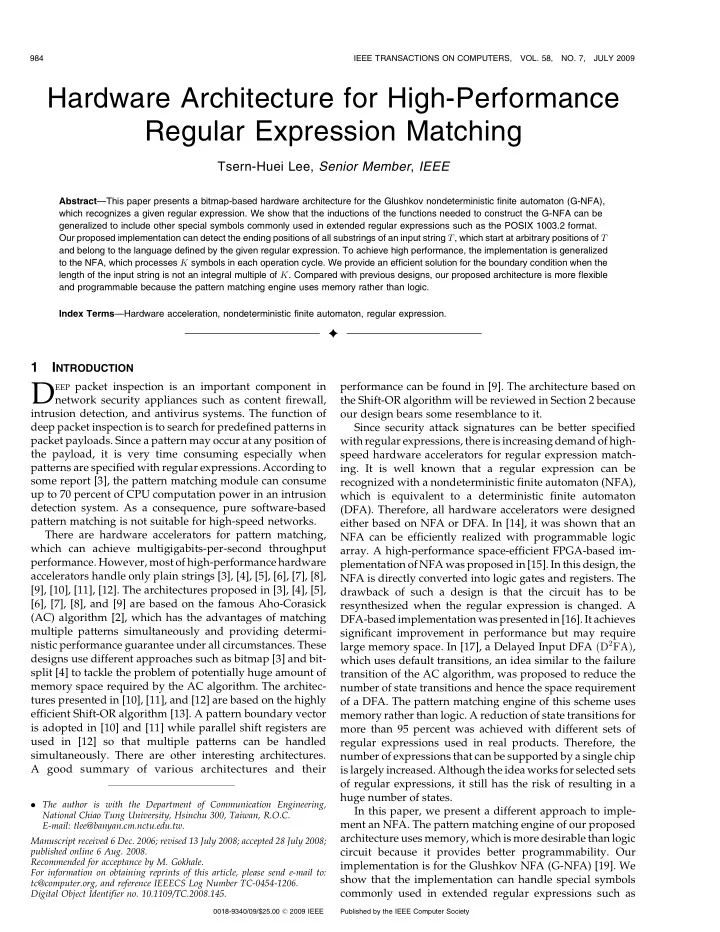

984 IEEE TRANSACTIONS ON COMPUTERS, VOL. 58, NO. 7, JULY 2009 Hardware Architecture for High-Performance Regular Expression Matching Tsern-Huei Lee, Senior Member , IEEE Abstract —This paper presents a bitmap-based hardware architecture for the Glushkov nondeterministic finite automaton (G-NFA), which recognizes a given regular expression. We show that the inductions of the functions needed to construct the G-NFA can be generalized to include other special symbols commonly used in extended regular expressions such as the POSIX 1003.2 format. Our proposed implementation can detect the ending positions of all substrings of an input string T , which start at arbitrary positions of T and belong to the language defined by the given regular expression. To achieve high performance, the implementation is generalized to the NFA, which processes K symbols in each operation cycle. We provide an efficient solution for the boundary condition when the length of the input string is not an integral multiple of K . Compared with previous designs, our proposed architecture is more flexible and programmable because the pattern matching engine uses memory rather than logic. Index Terms —Hardware acceleration, nondeterministic finite automaton, regular expression. Ç 1 I NTRODUCTION D EEP packet inspection is an important component in performance can be found in [9]. The architecture based on network security appliances such as content firewall, the Shift-OR algorithm will be reviewed in Section 2 because intrusion detection, and antivirus systems. The function of our design bears some resemblance to it. deep packet inspection is to search for predefined patterns in Since security attack signatures can be better specified packet payloads. Since a pattern may occur at any position of with regular expressions, there is increasing demand of high- the payload, it is very time consuming especially when speed hardware accelerators for regular expression match- patterns are specified with regular expressions. According to ing. It is well known that a regular expression can be some report [3], the pattern matching module can consume recognized with a nondeterministic finite automaton (NFA), up to 70 percent of CPU computation power in an intrusion which is equivalent to a deterministic finite automaton detection system. As a consequence, pure software-based (DFA). Therefore, all hardware accelerators were designed pattern matching is not suitable for high-speed networks. either based on NFA or DFA. In [14], it was shown that an There are hardware accelerators for pattern matching, NFA can be efficiently realized with programmable logic which can achieve multigigabits-per-second throughput array. A high-performance space-efficient FPGA-based im- performance. However, most of high-performance hardware plementation of NFA was proposed in [15]. In this design, the accelerators handle only plain strings [3], [4], [5], [6], [7], [8], NFA is directly converted into logic gates and registers. The [9], [10], [11], [12]. The architectures proposed in [3], [4], [5], drawback of such a design is that the circuit has to be [6], [7], [8], and [9] are based on the famous Aho-Corasick resynthesized when the regular expression is changed. A (AC) algorithm [2], which has the advantages of matching DFA-based implementation was presented in [16]. It achieves multiple patterns simultaneously and providing determi- significant improvement in performance but may require nistic performance guarantee under all circumstances. These large memory space. In [17], a Delayed Input DFA ð D 2 FA Þ , designs use different approaches such as bitmap [3] and bit- which uses default transitions, an idea similar to the failure split [4] to tackle the problem of potentially huge amount of transition of the AC algorithm, was proposed to reduce the memory space required by the AC algorithm. The architec- number of state transitions and hence the space requirement tures presented in [10], [11], and [12] are based on the highly of a DFA. The pattern matching engine of this scheme uses efficient Shift-OR algorithm [13]. A pattern boundary vector memory rather than logic. A reduction of state transitions for is adopted in [10] and [11] while parallel shift registers are more than 95 percent was achieved with different sets of used in [12] so that multiple patterns can be handled regular expressions used in real products. Therefore, the simultaneously. There are other interesting architectures. number of expressions that can be supported by a single chip A good summary of various architectures and their is largely increased. Although the idea works for selected sets of regular expressions, it still has the risk of resulting in a huge number of states. . The author is with the Department of Communication Engineering, In this paper, we present a different approach to imple- National Chiao Tung University, Hsinchu 300, Taiwan, R.O.C. ment an NFA. The pattern matching engine of our proposed E-mail: tlee@banyan.cm.nctu.edu.tw. architecture uses memory, which is more desirable than logic Manuscript received 6 Dec. 2006; revised 13 July 2008; accepted 28 July 2008; published online 6 Aug. 2008. circuit because it provides better programmability. Our Recommended for acceptance by M. Gokhale. implementation is for the Glushkov NFA (G-NFA) [19]. We For information on obtaining reprints of this article, please send e-mail to: show that the implementation can handle special symbols tc@computer.org, and reference IEEECS Log Number TC-0454-1206. commonly used in extended regular expressions such as Digital Object Identifier no. 10.1109/TC.2008.145. 0018-9340/09/$25.00 � 2009 IEEE Published by the IEEE Computer Society
Recommend
More recommend